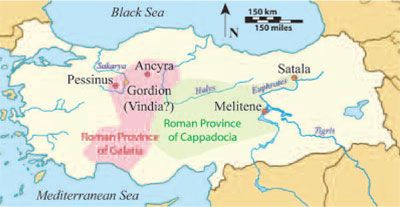 At the age of 20, Tritus, the son of Bato, joined the Roman army as a soldier of the VII Breucorum Cohors Equitata, an auxiliary unit composed of cavalry and infantry which acted in support of a Roman legionary force. Like many members of the Roman auxilia, this young provincial was possibly drawn into a military career with the understanding that he and his family (if any) would receive Rome’s supreme reward—citizenship—upon the successful completion of a 25-year term of service (or stipendium). Sadly, after serving only 12 years, Tritus died from causes unknown on the high, arid plateau of central Turkey, far from his native Pannonia (modern Hungary). Shortly afterward, acting on Tritus’ instructions, Mersua (son of Dasius)—his heir, fellow soldier, and most likely a Pannonian countryman—commissioned and had erected a tombstone for his former comrade-in-arms.
At the age of 20, Tritus, the son of Bato, joined the Roman army as a soldier of the VII Breucorum Cohors Equitata, an auxiliary unit composed of cavalry and infantry which acted in support of a Roman legionary force. Like many members of the Roman auxilia, this young provincial was possibly drawn into a military career with the understanding that he and his family (if any) would receive Rome’s supreme reward—citizenship—upon the successful completion of a 25-year term of service (or stipendium). Sadly, after serving only 12 years, Tritus died from causes unknown on the high, arid plateau of central Turkey, far from his native Pannonia (modern Hungary). Shortly afterward, acting on Tritus’ instructions, Mersua (son of Dasius)—his heir, fellow soldier, and most likely a Pannonian countryman—commissioned and had erected a tombstone for his former comrade-in-arms.
Such was the life of an average Roman soldier, his story resurrected thanks to the fortuitous discovery in 1996 of his tombstone at Gordion. Although this particular find was accidental—a local farmer plowed up a large limestone block in his fields alongside the Sakarya River—the site of Gordion (located about 95 km southwest of modern Ankara) has been the focus of excavation and research by the Penn Museum and a number of affiliated institutions since 1950. Best known as the Iron Age (ca. 950–540 BC) capital of the Phrygians and for its connection to the semi-legendary King Midas, over the decades Gordion and its surroundings have yielded thousands of artifacts dating from the Early Bronze Age (ca. 2500–2000 BC) through the medieval period (13th–14th centuries AD).
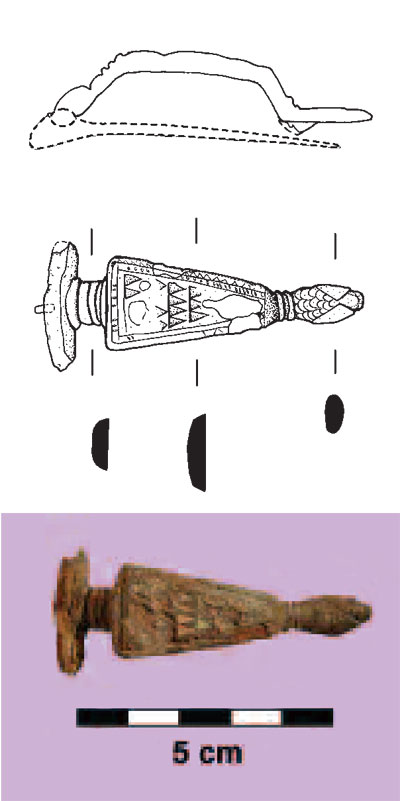
Inspection of the limestone block revealed that it was a funerary stele, largely intact (ca. 1.42 m tall) and belonging to the Roman Imperial period (1st–4th centuries AD), when a small settlement existed atop Gordion’s Citadel Mound. The stele was exceptionally well-preserved, with abundant traces of red paint, often applied in antiquity to the lettering of such monuments still visible in the characters of its eight-line dedicatory inscription.
The epitaph was uncommon for this region of the Roman Empire—the province of Galatia—as it was composed in Latin, a language used far less frequently than Greek in the official and private inscriptions of the Roman East. Within Galatia’s rural environs, beyond the immediate proximity of the province’s few cities, this Latin dedication would certainly have presented an odd sight to locals and passersby, the majority of whom—assuming they were literate—would probably have not understood it.
The Latin language, however, often accompanied Rome’s army in the East, and the western origin of our Pannonian soldier, Tritus, undoubtedly explains its appearance at Gordion. Hundreds of such dedicatory inscriptions about soldiers’ lives are found across the Roman world. Written in a nearly formulaic style, they convey similar factual details, such as age, unit, and birthplace. The narrative in Tritus’ epitaph proves quite typical, reflecting an obvious pride in his service to Rome despite a career that appears to have been largely undistinguished by awards of merit or advancement in rank.
Rediscovering Roman Gordion
While the tombstone’s narrative proved to be relatively commonplace, its discovery at Gordion raised new questions about the site’s history and function under the Roman Empire. What was the VII Breucorum or one of its detachments (vexillatio) doing at Gordion? When were they there? And, perhaps most importantly, was this military presence at Gordion merely temporary, or was the VII Breucorum or other auxiliary cohorts stationed there at a permanent base?
Until recently relatively little was known about the character or function of Gordion during the Roman period. The only surviving literary reference to Roman Gordion comes from the early 1st century AD, when the geographer Strabo informs us that the once-celebrated city had dwindled to little more than a village, albeit one slightly larger than the surrounding villages. Excavation at the site, under the direction of Rodney S. Young between 1950 and 1973, provided few clues about the Roman period occupation. At the time of the stele’s discovery in 1996, only small portions of the Roman period settlement had been investigated, on those infrequent occasions when Young and his team had probed along the settlement’s western, northwestern, and northeastern edges. Finds recovered from the Roman period settlement received little attention or publication, overshadowed by the impressive monuments and objects that emerged from Gordion’s earlier Iron Age strata. Therefore, with no evidence to the contrary, Roman Gordion was customarily portrayed as a mere country hamlet with none of the strategic and economic importance it possessed in pre-Roman times.
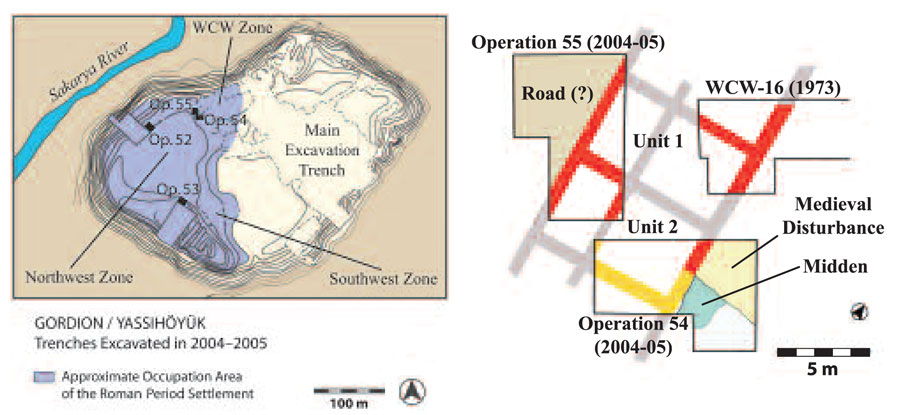
(Right) Our excavations in Operations 54 and 55 revealed the remains of a large 1st–2nd century AD structure, whose northern portions had previously been unearthed within Operation WCW-16 in 1973. While some walls were intact (red), others (yellow) were completely robbed by Gordion’s medieval inhabitants, leaving only their foundation trenches. Conjectured walls are depicted in grey.
By the late 1990s, however, new excavations and analyses of earlier finds began to produce a more nuanced understanding of Roman Gordion. Between 1993 and 2002, excavations by Mary M. Voigt and her team exposed the Roman period town’s earliest occupational strata for the first time. This allowed examination of the entire span of Roman period occupation on the Citadel Mound—a phase now recognized as extending from the early 1st to the early 5th century AD. Before this time, during the Late Hellenistic period, the Citadel Mound had witnessed near complete abandonment by the late 2nd century BC. Therefore, Roman Gordion represented a fresh foundation on the mound during the early Roman Imperial era (1st century AD). The new settlers—possibly arriving shortly after Galatia’s annexation in 25 BC by the Roman Emperor Augustus—carefully leveled the mound’s surface and the abandoned Late Hellenistic structures. They then established an entirely new and unprecedented north-south axial grid on the mound. While the exact identity of these new inhabitants continues to be debated, their architecture, such as laboriously constructed subterranean drainage conduits, indicates that they were exceedingly well organized and had a careful plan in mind and the resources necessary to implement it.
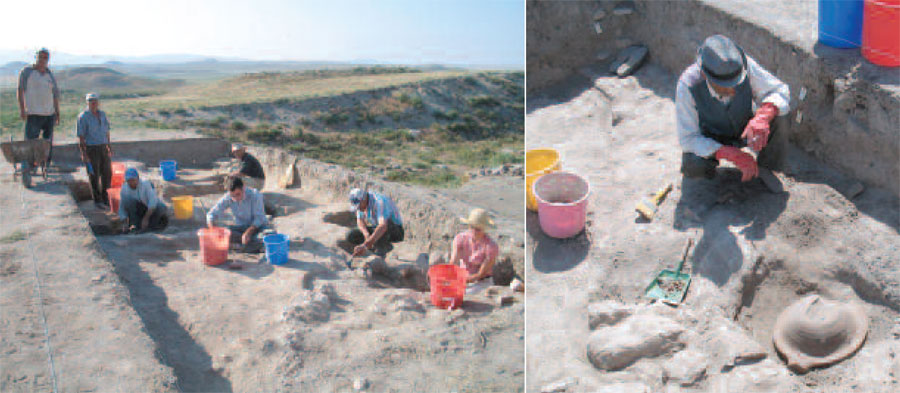
(Right) Excavation of the midden heap in Operation 54 yielded large quantities of iron and bronze objects, such as Roman armor and weapons, as well as nearly complete ceramic vessels, including this overturned spouted mixing bowl (mortarium).
Furthermore, close examination of the previously excavated artifacts housed in the Gordion Project depots has revealed that the Roman period settlement was moderately prosperous, particularly during the late 1st and early 2nd centuries AD. Excavations have recovered imported artifacts of high quality from the mound and cemeteries surrounding the site, including fine ware ceramics, glass vessels, carved bone implements, and gold and silver jewelry. Dozens of stray coins—the lost pocket change of antiquity—have been recovered from the Citadel Mound and indicate that the local economy was relatively dynamic. These include a wide range of denominations from high-value coins like the silver denarius to smaller, low-value bronze coins that have been clipped in half—a practical solution in Roman times to make small change for local or daily transactions. Coinage circulation and exchange thus seems to have been a regular phenomenon at Gordion in Roman times, much as it was in the larger towns and cities of the Empire.
Since Roman Gordion remained comparatively small in size throughout its existence—about 3 hectares at its greatest extent—the economy probably prospered because of Gordion’s location at an important crossing of the Sakarya River along the major Roman highway between Ancyra and Pessinus, two of Galatia’s major cities. It now seems quite probable that Roman Gordion served, at least in part, as a market town or emporium of local trade similar in type (though far smaller in actual size and population) to Gordion’s commercial character in pre-Roman times.
Military Deployment In Anatolia
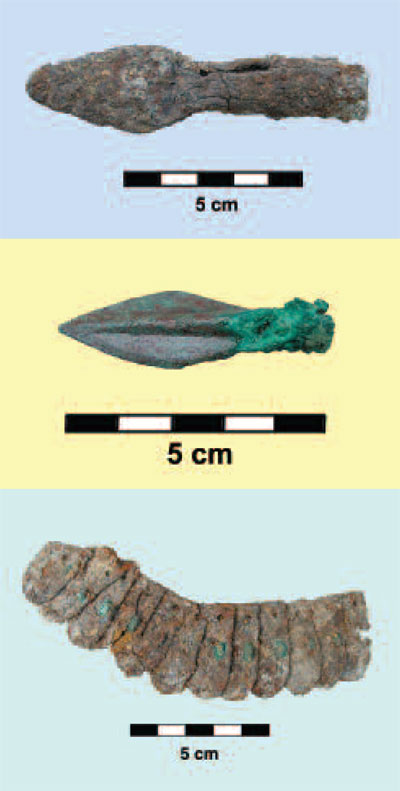
Middle, while weapons have been found in pre-Roman contexts at Gordion, this bronze arrowhead, carefully cleaned and stabilized by Gordion’s conservation team, is one of the first that can be securely dated to the Roman period.
Bottom, among the remnants of armor discovered in Operations 54 and 55, this well-preserved example of scale mail (lorica squamata) was still linked together by its original copper-alloy wire. The remains of the mate- rial upon which the scales were hung may survive in the traces of leather revealed by careful cleaning on its backside.
While our understanding of Roman Gordion’s physical development, material culture, and economic function has improved in recent years, no concrete evidence for a Roman military presence at Gordion existed prior to the discovery of the inscribed stele. There were no fortifications, barracks, or even military equipment such as armor or weapons. The only hints we had for soldiers or veterans resident in the vicinity were some objects found in a nearby Roman period cemetery, such as a military horse pendant from a child’s burial, signet rings bearing gems carved with martial symbols, and the remains of hobnailed boots. Similarly, evidence for contact or trade between Gordion and the Roman provinces to the west was tantalizing but scant, for example, an enameled ‘Snake’s head foot’ bow brooch common to the regions of the upper Rhine and Danube Rivers.
Indeed, in view of the historically known disposition of Roman forces within Anatolia (modern Turkey), Gordion seemed an unlikely candidate for a permanent or semi-permanent base. Galatia, an inland province some distance from the Empire’s borders (limes), was what the ancient historian Tacitus termed an “unarmed province” (inermis provincia) with no Roman legions or significant permanent military forces. The closest legionary bases were over 550 km to the east on the Euphrates River frontier at Melitene and Satala. Galatia, of course, was not wholly devoid of soldiers. Auxiliary cohorts in the province fulfilled a variety of essential (though hardly glamorous) tasks, such as guarding imperial officials, patrolling the roadways, gathering supplies, and acting as messengers. Their number at any given time, however, was likely to have been quite small, and inscriptions indicate that they tended to be based in the province’s capital cities or at strategic sites.
Tiny, rural Gordion would thus seem to have been an unlikely destination for the VII Breucorum, a unit normally stationed in Central Europe along the Rhine and Danubian frontiers whose presence is currently unknown elsewhere in Turkey. This is not to say that auxiliary cohorts never changed locations. We possess plentiful evidence indicating that they could on occasion be called away on active duty, not unlike our National Guardsmen.
According to an inscription from Knodara in Cyprus that was dedicated by the cohort’s commanding officers, the VII Breucorum itself briefly passed through northeastern Cyprus in the early 2nd century AD, probably on its way to contend with an uprising in Judaea (modern Israel/Palestine) in AD 115 or 116. The Gordion inscription is plausibly a product of
the same or a closely related mission, which all formed part of mass troop relocations during the Emperor Trajan’s Parthian War (ca. AD 113–117). Furthermore, a recently discovered military diploma—the official document given to a soldier upon the completion of his term of service to certify that he has received citizenship—found in the province of Lower Moesia (modern Romania) mentions that a cohors VII was absent on assignment from the province in AD 115. Its route to either the Euphrates frontier or Cyprus could have taken them through central Anatolia and the major road nexus at Ancyra. From Ancyra its soldiers could have been deployed throughout Galatia to collect supplies and protect the roadways.
Given our current understanding of Galatia’s military forces, two plausible explanations therefore exist to account for the cohort’s deployment at Gordion. First, based upon surviving Roman road itineraries, Gordion may be equated with Vindia, an imperial posting station (statio) listed along the Ancyra-Pessinus highway in Gordion’s general vicinity. Such stations served a number of important functions, including protecting the road, suppressing banditry, collecting taxes and military supplies, and transferring government and military communications. If Gordion and Vindia are the same, it would not be surprising to find the VII Breucorum at Gordion to support the legions and other forces marching east across central Anatolia during Trajan’s war.
Alternatively, Gordion might have had a higher strategic value to the imperial administration than we have previously assumed since it controlled an important roadway, river crossing, and communication route. If this were the case, perhaps a larger and more permanent base was established at Gordion. This might explain some of the intriguing contents of Gordion’s cemeteries, such as the high percentage of graves containing remnants of hobnailed boots (caligae) often associated with the presence of soldiers. It would also account for the time that was needed for Mersua to have Tritus’ stele commissioned, carved, and transported to Gordion from a workshop probably located in Ancyra or Pessinus.
New Excavations In the Romantown
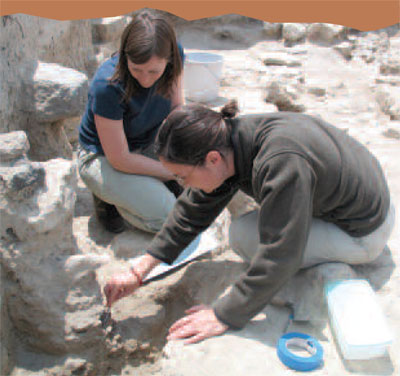
With Gordion’s military identity in mind, in 2004 I initiated a new exploration of its Roman period occupation to investigate its settlement plan, developmental history, and overall function. This was the first time that the Roman period settlement formed the primary objective of archaeological fieldwork at Gordion. Over two field seasons and ten weeks of excavation we explored three sectors of the Citadel Mound where Young’s earlier probes had confirmed the presence of Roman period structures. These locations were deliberately selected to reduce the risk of missing the targeted strata, the Roman period settlement that was confined to the western third of the mound. Fortuitously, they were also widely separated across the site, permitting us to detect possible changes in the settlement’s size and function over time. Limited time and funding focused our research on four 5 x 10 m trenches (Operations 52–55), each of which were excavated down to the earliest Roman levels we could reach in the time allotted.
The first confirmation of a Roman military presence came surprisingly swiftly, after only three days of digging in Operation 54. Less than 20 cm below the modern surface we found a large deposit of scrap metal and assorted refuse—the top layer of a large midden (garbage dump) located behind the rear wall of a substantial building. Over the ten weeks of digging, this pile would produce a trove of military finds, including an iron javelin point and a bronze arrowhead, the first examples of Roman weapons found at Gordion. We also unearthed medallions and pendants commonly worn as military decorations and numerous fragments of Roman armor, both iron and bronze scales and hundreds of small rings—the remnants of ancient chain mail. In 2005, the excavation of Operation 55 (inside an adjoining room of the same large structure) brought to light an impressive cluster of iron mail, with 12 scales still linked together by loops of copper or bronze wire.
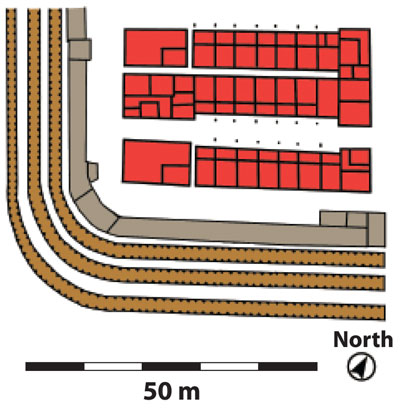
In addition to the military equipment, we also recovered ceramic bowl forms typical of the Neronian and Flavian periods, a glass teardrop bottle, and a leaf-shaped lamp handle, all of which helped date the building to the latter half of the 1st century AD. Although only portions of the building itself could be examined and its plan remains incomplete, it clearly features front and back rooms of unequal size, with a thin crosswall separating the smaller room from the larger one in the rear. When we combine these architectural remains with walls unearthed to the north in 1973 (in the former trench WCW-16), our plan suggests that a larger structure was composed of at least two (possibly more) of these double units placed side by side in a repeating pattern. Julian Bennett, the trench supervisor in this area and an expert on the Roman military, contends that the dimensions and proportions of the conjoining rooms are directly comparable with those found in Roman legionary and auxiliary barracks of the 1st and 2nd centuries AD. If this is the case, then we have discovered not only artifacts probably belonging to the Roman military but also evidence of a Roman camp—the first of its type to be excavated in Turkey.
These new excavations have shown that Roman Gordion functioned, at least in part, as a military fort, with soldiers operating in the vicinity during the latter half of the 1st century AD, about the same time that legionary bases were established along the Euphrates River at Satala and Melitene. Around AD 75–80, Galatia’s provincial infrastructure underwent a massive upgrade, and changes in Anatolia’s military network at this time may have necessitated small, rural bases at places like Gordion that could generate supplies and protect lines of communication. While our 2004–2005 excavations unearthed no evidence to confirm the name of the unit(s) stationed at Gordion or whether Roman Gordion was the statio Vindia, our recent fieldwork has helped significantly to clarify the character of Gordion’s later occupation, delineating the home base for the Roman soldier Tritus, who lived and died there in service to his empire.
Bogaers, J. E. “Cohortes Breucorum.” Berichten van de Rijksdienst voor het Oudheidkundig Bodemonderzoek 19 (1969):27-50.
Goldman, Andrew L. “A New Military Inscription from Gordion, Turkey.” Anadolu Medeniyetleri Müsezi Yilligi 12 (1997):45-58.
Goldman, Andrew L. “A Roman Town Cemetery at Gordion, Turkey.” Expedition 43-2 (2001):9-20.
Mitchell, Stephen. Anatolia: Land, Men and Gods in Asia Minor. 2 vols. Oxford: Clarendon Press, 1992.
Sherk. Robert K. “The inermes provinciae of Asia Minor.” American Journal of Philology 76 (1955):400-13.
Spiedel, Michael P. “The Roman Army in Asia Minor: Recent Epigraphical Discoveries and Research.” In Armies and Frontiers in Roman and Byzantine Anatolia, edited by Stephen Mitchell, pp. 7-34. Oxford: British Archaeological Reports International Series 156, 1983.
Webster, Graham. The Roman Imperial Army of the First and Second Centuries A.D. 3rd ed. Norman, OK: University of Oklahoma Press, 1998.
